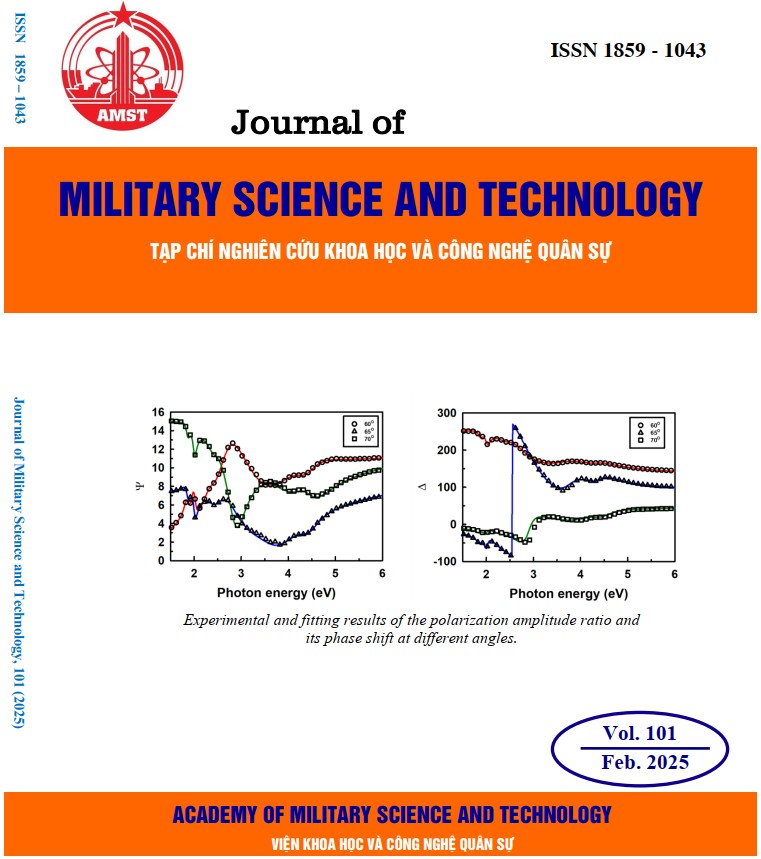Research on the fabrication of composite materials based on unsaturated polyester resin matrix and modified rice husk reinforcement
493 viewsDOI:
https://doi.org/10.54939/1859-1043.j.mst.101.2025.72-80Keywords:
Rice husk; Natural fiber; UPE composite; 3-methacryloxypropyltrimethoxysilane; Mechanical properties.Abstract
In this study, rice husks (RHs) were utilized as fillers to create a reinforcing phase during the fabrication of composites based on an unsaturated polyester (UPE) resin matrix. The aim was to maintain the mechanical properties of the materials at a certain level and partially replace the amount of thermosetting resin used, thereby reducing negative environmental impacts. Sodium hydroxide (NaOH) and 3-methacryloxypropyltrimethoxysilane (MPS) were employed in the modification process of the RHs. The structure and morphology of the modified RHs were investigated using Fourier-transform infrared (FTIR) spectroscopy and field emission scanning electron microscopy (FESEM). Additionally, the mechanical properties of composite samples were evaluated according to international standards, such as ISO 527:2012, ISO 178:2019, ISO 604:2002, and ASTM D256. The results showed that the RHs sequentially modified by a NaOH solution and a MPS-dissolved mixture significantly improved the mechanical properties of the respective composites, compared to the composites with untreated RHs and RHs chemically modified by one solution. Specifically, compared to the reference samples formed by raw RHs, the best composite among ones with two-stage-treated RHs demonstrated flexural strength with an increase of 34.1% (reaching 45.1 MPa), compressive strength with a climb of 51.6% (reaching 33.8 MPa), tensile strength rising by 44.6% (at 34.3 MPa), and impact strength of 6.3 kJ/m² (18.9% higher). These results indicate that modified RHs can meet the research objectives and pave the way for further studies on RH-based composites.
References
[1]. M. Gun et al., "Optimization of Silica Extraction from Rice Husk Using Response Surface Methodology and Adsorption of Safranin Dye," International Journal of Environmental Research, vol. 16, no. 2, p. 20, (2022). DOI: https://doi.org/10.1007/s41742-022-00399-5
[2]. N. Karić et al., "Bio-waste valorisation: Agricultural wastes as biosorbents for removal of (in)organic pollutants in wastewater treatment," Chemical Engineering Journal Advances, vol. 9, p. 100239, (2022). DOI: https://doi.org/10.1016/j.ceja.2021.100239
[3]. L. Q. Dien et al., "Rice husk integrated biochemical refinery for the production of nano- and bioproducts," Process Biochemistry, vol. 121, pp. 647-655, (2022). DOI: https://doi.org/10.1016/j.procbio.2022.08.009
[4]. B. S. Ndazi et al., "Chemical and physical modifications of rice husks for use as composite panels," Composites Part A: Applied Science and Manufacturing, vol. 38, no. 3, pp. 925-935, (2007). DOI: https://doi.org/10.1016/j.compositesa.2006.07.004
[5]. P. Senthamaraikannan and M. Kathiresan, "Characterization of raw and alkali treated new natural cellulosic fiber from Coccinia grandis.L," Carbohydrate Polymers, vol. 186, pp. 332-343, (2018). DOI: https://doi.org/10.1016/j.carbpol.2018.01.072
[6]. S. Sreenivasan et al., "Evaluation of Combined Treatments of Natural Fibers: Kenaf, Abaca and Oil Palm Fibers Using Micromechanical and SEM Methods.," AMR 912–914, 1932–1939., (2014). DOI: https://doi.org/10.4028/www.scientific.net/AMR.912-914.1932
[7]. V. A. Yiga et al., "Thermal stability of NaOH modified rice husk fiber-reinforced polylactic acid composites: Effect of rice husks and clay loading," Results in Materials, vol. 18, p. 100398, (2023). DOI: https://doi.org/10.1016/j.rinma.2023.100398
[8]. V. A. Yiga et al., "Modified rice husk as component in recyclable and biodegradable epoxy thermosets," Discover Applied Sciences, vol. 6, no. 4, p. 175, (2024). DOI: https://doi.org/10.1007/s42452-024-05834-0
[9]. Y. Nakamura et al., "Characterization of cellulose microfibrils, cellulose molecules, and hemicelluloses in buckwheat and rice husks," Cellulose, vol. 26, no. 11, pp. 6529-6541, (2019). DOI: https://doi.org/10.1007/s10570-019-02560-4
[10]. L. Mohammed et al., "A review on natural fiber reinforced polymer composite and its applications," vol. 2015, (2015). DOI: https://doi.org/10.1155/2015/243947
[11]. A. Dilfi et al., "Effect of surface modification of jute fiber on the mechanical properties and durability of jute fiber-reinforced epoxy composites," vol. 39, pp. E2519-E2528, (2018). DOI: https://doi.org/10.1002/pc.24817
[12]. M. H. Hamidon et al., "Effects of fibre treatment on mechanical properties of kenaf fibre reinforced composites: a review," Journal of Materials Research and Technology, vol. 8, no. 3, pp. 3327-3337, (2019). DOI: https://doi.org/10.1016/j.jmrt.2019.04.012
[13]. E. T. N. Bisanda and M. P. Ansell, "The effect of silane treatment on the mechanical and physical properties of sisal-epoxy composites," Composites Science and Technology, vol. 41, no. 2, pp. 165-178, (1991). DOI: https://doi.org/10.1016/0266-3538(91)90026-L
[14]. M. Bengtsson and K. Oksman, "Silane crosslinked wood plastic composites: Processing and properties," Composites Science and Technology, vol. 66, no. 13, pp. 2177-2186, (2006). DOI: https://doi.org/10.1016/j.compscitech.2005.12.009
[15]. A. K. Bledzki and J. Gassan, "Composites reinforced with cellulose based fibres," Progress in Polymer Science, vol. 24, no. 2, pp. 221-274, (1999). DOI: https://doi.org/10.1016/S0079-6700(98)00018-5
[16]. Y. Xie et al., "Silane coupling agents used for natural fiber/polymer composites: A review," Composites Part A: Applied Science and Manufacturing, vol. 41, no. 7, pp. 806-819, (2010). DOI: https://doi.org/10.1016/j.compositesa.2010.03.005
[17]. P. Gañán and I. J. J. o. m. s. Mondragon, "Fique fiber-reinforced polyester composites: Effects of fiber surface treatments on mechanical behavior," vol. 39, pp. 3121-3128, (2004). DOI: https://doi.org/10.1023/B:JMSC.0000025841.67124.c3
[18]. B. Singh et al., "Influence of fiber surface treatment on the properties of sisal‐polyester composites," vol. 17, no. 6, pp. 910-918, (1996). DOI: https://doi.org/10.1002/pc.10684
[19]. L. A. Pothan et al., "The role of fibre/matrix interactions on the dynamic mechanical properties of chemically modified banana fibre/polyester composites," vol. 37, no. 9, pp. 1260-1269, (2006). DOI: https://doi.org/10.1016/j.compositesa.2005.09.001
[20]. L. A. Pothan et al., "Polarity parameters and dynamic mechanical behaviour of chemically modified banana fiber reinforced polyester composites," vol. 63, no. 9, pp. 1231-1240, (2003). DOI: https://doi.org/10.1016/S0266-3538(03)00092-7
[21]. R. Arjmandi et al., "Rice Husk Filled Polymer Composites," International Journal of Polymer Science, vol. 2015, p. 501471, (2015). DOI: https://doi.org/10.1155/2015/501471
[22]. M. Abdelmouleh et al., "Modification of cellulose fibers with functionalized silanes: effect of the fiber treatment on the mechanical performances of cellulose–thermoset composites," vol. 98, no. 3, pp. 974-984, (2005). DOI: https://doi.org/10.1002/app.22133
[23]. D. Deepaky et al., "Bibliometric Analysis of Research Trends in Rice Straw/Husk Reinforced Polymer Composites," pp. 1-36, (2021).
[24]. A. A. Ajayi et al., "Development of epoxy-based sandwich composite panel with hollow glass microspheres/clay hybrid core and banana fiber facesheet for structural applications," Heliyon, vol. 10, no. 9, p. e30428, (2024). DOI: https://doi.org/10.1016/j.heliyon.2024.e30428
[25]. M. S. Yeasmin and M. I. H. Mondal, "Synthesis of highly substituted carboxymethyl cellulose depending on cellulose particle size," International Journal of Biological Macromolecules, vol. 80, pp. 725-731, (2015). DOI: https://doi.org/10.1016/j.ijbiomac.2015.07.040
[26]. G. Herbst et al., "Silane-modified high-yield lignocellulosic fibers as reinforcement of polylactic acid: Enhancement of interfacial adhesion for high-performance biocomposites," Industrial Crops and Products, vol. 218, p. 119027, (2024). DOI: https://doi.org/10.1016/j.indcrop.2024.119027
[27]. R. Javier-Astete et al., "Determination of hemicellulose, cellulose, holocellulose and lignin content using FTIR in Calycophyllum spruceanum (Benth.) K. Schum. and Guazuma crinita Lam," vol. 16, no. 10, p. e0256559, (2021). DOI: https://doi.org/10.1371/journal.pone.0256559
[28]. A. K. Mohanty et al., "Natural fibers, biopolymers, and biocomposites: an introduction," in Natural fibers, biopolymers, and biocomposites: CRC press, pp. 17-51, (2005). DOI: https://doi.org/10.1201/9780203508206.ch1
[29]. X. Li et al., "Chemical treatments of natural fiber for use in natural fiber-reinforced composites: a review," vol. 15, pp. 25-33, (2007). DOI: https://doi.org/10.1007/s10924-006-0042-3
[30]. P. K. Kushwaha et al., "Studies on water absorption of bamboo-polyester composites: effect of silane treatment of mercerized bamboo," vol. 49, no. 1, pp. 45-52, (2009). DOI: https://doi.org/10.1080/03602550903283026
[31]. M. Abdelmouleh et al., "Interaction of silane coupling agents with cellulose," vol. 18, no. 8, pp. 3203-3208, (2002). DOI: https://doi.org/10.1021/la011657g







